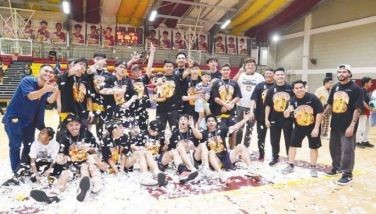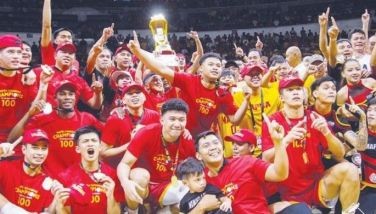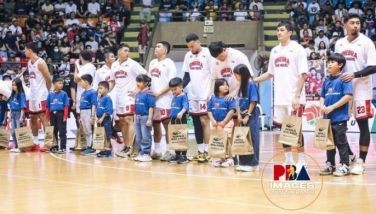Squash kids shine in Japan

April 16, 2003 | 12:00am
It’s not often that a Filipino squash player makes waves abroad. At the Southeast Asian (SEA) Games, the highest finish the Philippines posted in the sport was third as the national men’s team has pocketed bronze medals in the last six stagings of the biennial event.
So when three teenaged kids returned home with medals from the six-nation 16th Japan Junior Open in Yokohama last week, there was reason for Philippine Olympic Committee (POC) secretary-general and Squash Rackets Association of the Philippines (SRAP) president Romeo Ribano to applaud the feat.
Christian Balahadia, 14, beat Lee Nge On-Ho of South Korea, 9-1, 9-2, to win the under-15 Classic Plate title. Robert Garcia, 16, reached the semifinals of the under-17 class and settled for the bronze medal after losing to eventual champion Yuta Fukui of Japan. And Jesu Rainne (JR) Garcia, 16, took second place in the under-17 Classic Plate bracket.
Not a bad showing for kids who traveled outside the country for the first time.
The intrepid teeners were accompanied by national coach Edgar Balleber, a veteran internationalist. They took a three-hour flight to Narita then boarded a train for the 1 1/2 hour ride to Yokohama before a 45-minute bus trip to Shonandai where the group was billeted. It wasn’t exactly a joy ride. The exhausted kids checked in at their hotel a few minutes after midnight.
But once the kids got on the court at the Kotekote Squash Club, they played their guts out.
Balahadia, a sophomore at St. Francis High School, created a stir in his first assignment as he blanked Nozomi Takahashi, 9-0, 9-0, 9-0. Then he lost a 7-9, 9-2, 9-7, 9-2 heartbreaker to Shinosuke Tsukue. Balahadia fell to the Classic Plate bracket for second round losers and breezed to the championship, crushing Teruhiko Tobe, 9-0, 9-0, and On-Ho.
Balahadia, whose father Milo is an electrical engineer and mother Liliosa is a nurse, is one of three children. He was the Class B champion in the first leg of this year’s national circuit.
Robert Garcia, a junior at Mariano Marcos Memorial High School, drew a bye in the first round of the under-17 bracket then upset Bunpei Kawano, 4-9, 9-6, 10-8, 10-9 to arrange a semifinals duel with Fukui. Garcia dropped a 9-3, 9-1, 9-7 decision to Fukui who went on to capture the title. His effort was good for a bronze medal.
Garcia ruled Class B in the SRAP National Tournament in 2001.
Garcia’s cousin JR also clicked in his initial match, trouncing Tohru Asakura, 9-2, 9-4, 9-0 in the under-17 bracket. He lost a 9-3, 9-0, 9-0 verdict to Ken Okada in the second round and dropped to the Classic Plate competition where he beat Lim Hyuek, 9-2, 9-1, and bowed to Kawano, 6-9, 9-4, 9-3, in a Finals thriller.
JR was the Class B titlist in the fourth leg of the national circuit last year and singled out world champion Peter Nicol of England as his squash idol. His favorite weapons are the drop and the length shot close to the wall.
"I like playing squash because it gives me confidence as a person," said JR. "Being in the junior team, it helps develop my physical and mental potentials." His ambition is to become the No. 1 squash player in the country.
In all, the squash kids won six of 10 matches in Yokohama where 184 players participated in the under-11, 13, 15, 17, 19 categories for boys and girls. The entries were from Japan, Hong Kong, Chinese-Taipei, South Korea, Singapore, and the Philippines.
The boys are among four players in the national juniors pool supported by the Philippine Sports Commission (PSC). The other player is Patrick Ginon. The five players in the seniors pool are Ricky Espinola, Joeby Antipala, Berto Carin, Arnel Bigornia, and Allan Belano. Balleber is listed in the national coaching pool with Jaime Ortua and Jun Paganpan.
Balleber, 32, played on the Philippine squad that took the silver medal at the East Asian Championships in Kuala Lumpur in 1991. He also bagged a silver in the team event at the Arafura Festival in Darwin, Australia, that same year.
Balleber, a squash pro at the Manila Boat Club and the Palms Country Club in Alabang, won four national tournaments last year and is a three-time grand slam champion in the local circuit. As a national coach, his goal is to produce high-caliber players and as a player himself, his dream is to play in the Olympics once squash is entered in the calendar.
Lobbyists are hoping to someday include squash in the Olympics and justify their position by noting that it is now played in 144 countries and 119 are affiliated with the World Squash Federation.
"Squash is a very good exercise in putting myself in great shape," said Balleber whose court idols are Jansher Khan of Pakistan and Zainal Abidin of Singapore. "It teaches me to be a responsible and disciplined individual. It gives me a chance to play internationally and meet popular athletes. And as my profession, it is my bread and butter."
Balleber said the lack of public courts in the country is a hindrance to the development of squash.
About 60 courts exist in the country. Tagaytay Highlands has two air-conditioned courts. So does the Palms Country Club which imported wooden flooring for the courts. There are also courts at the Orchard Golf and Country Club, Rockwell, Green Valley, Valle Verde, Quezon City Sports Club, Nomads Club, Alabang Country Club, Philippine Columbian, the Pacific Towers, the Manila Broadcasting Corp. (MBC) building, Manila Polo Club, Asian Development Bank, Makati Sports Club, Manila Boat Club, Manila Hotel, and Punta Fuego in Nasugbu.
For Philippine Long Distance Telephone Co. chairman Manny Pangilinan, squash is the only game to play. He plays late nights at the Pacific Towers or with friends at the Manila Polo Club. Two of his frequent squashmates are prominent architects Bong Recio and Meloy Casas.
ABS-CBN head Gabby Lopez dominated the Alabang Country Club squash competitions some years back and his brother Ernie also played tough. The late Louie Beltran liked to whack the ball early mornings at the MBC top floor. Former US Ambassador Nicholas Platt was such an enthusiast that he had a court built at the Embassy grounds on Roxas Boulevard.
The story goes that squash was introduced here by British expatriates in the 1930s. A court was supposedly built but nobody seems to know where it was located. If such a court existed, it probably crumbled into rubble during World War II.
In 1967, Dr. Ronald Tablante returned home after graduating at Harvard University where he took up ophthalmology and built a roofless cement court in Quezon City.
In 1970, the Manila Boat Club inaugurated the first of its three squash courts in Santa Ana. More private clubs later built squash courts as the sport gained popularity among young professionals, expatriates, and fitness buffs.
In 1977, the Philippines hosted the second East Asian Championships and Filipino Fausto Preysler Jr., captured the singles title. Preysler’s triumph triggered a surge of interest in the sport.
Ribano said he plans to hire a foreign coach for the national team and raise funds to build public courts at the Rizal Memorial grounds.
Squash isn’t an expensive sport. You can buy a racket for less than P2,000 and squash shoes are relatively cheap because they’re lightweight and don’t use leather. You wear a shirt and a pair of shorts for playing–nothing fancy. But unless there are public courts, squash will never grow here as a sport for the masses. What a pity because Filipinos–as those three kids showed in Japan–are capable of playing world-class squash.
So when three teenaged kids returned home with medals from the six-nation 16th Japan Junior Open in Yokohama last week, there was reason for Philippine Olympic Committee (POC) secretary-general and Squash Rackets Association of the Philippines (SRAP) president Romeo Ribano to applaud the feat.
Christian Balahadia, 14, beat Lee Nge On-Ho of South Korea, 9-1, 9-2, to win the under-15 Classic Plate title. Robert Garcia, 16, reached the semifinals of the under-17 class and settled for the bronze medal after losing to eventual champion Yuta Fukui of Japan. And Jesu Rainne (JR) Garcia, 16, took second place in the under-17 Classic Plate bracket.
Not a bad showing for kids who traveled outside the country for the first time.
The intrepid teeners were accompanied by national coach Edgar Balleber, a veteran internationalist. They took a three-hour flight to Narita then boarded a train for the 1 1/2 hour ride to Yokohama before a 45-minute bus trip to Shonandai where the group was billeted. It wasn’t exactly a joy ride. The exhausted kids checked in at their hotel a few minutes after midnight.
But once the kids got on the court at the Kotekote Squash Club, they played their guts out.
Balahadia, a sophomore at St. Francis High School, created a stir in his first assignment as he blanked Nozomi Takahashi, 9-0, 9-0, 9-0. Then he lost a 7-9, 9-2, 9-7, 9-2 heartbreaker to Shinosuke Tsukue. Balahadia fell to the Classic Plate bracket for second round losers and breezed to the championship, crushing Teruhiko Tobe, 9-0, 9-0, and On-Ho.
Balahadia, whose father Milo is an electrical engineer and mother Liliosa is a nurse, is one of three children. He was the Class B champion in the first leg of this year’s national circuit.
Robert Garcia, a junior at Mariano Marcos Memorial High School, drew a bye in the first round of the under-17 bracket then upset Bunpei Kawano, 4-9, 9-6, 10-8, 10-9 to arrange a semifinals duel with Fukui. Garcia dropped a 9-3, 9-1, 9-7 decision to Fukui who went on to capture the title. His effort was good for a bronze medal.
Garcia ruled Class B in the SRAP National Tournament in 2001.
Garcia’s cousin JR also clicked in his initial match, trouncing Tohru Asakura, 9-2, 9-4, 9-0 in the under-17 bracket. He lost a 9-3, 9-0, 9-0 verdict to Ken Okada in the second round and dropped to the Classic Plate competition where he beat Lim Hyuek, 9-2, 9-1, and bowed to Kawano, 6-9, 9-4, 9-3, in a Finals thriller.
JR was the Class B titlist in the fourth leg of the national circuit last year and singled out world champion Peter Nicol of England as his squash idol. His favorite weapons are the drop and the length shot close to the wall.
"I like playing squash because it gives me confidence as a person," said JR. "Being in the junior team, it helps develop my physical and mental potentials." His ambition is to become the No. 1 squash player in the country.
In all, the squash kids won six of 10 matches in Yokohama where 184 players participated in the under-11, 13, 15, 17, 19 categories for boys and girls. The entries were from Japan, Hong Kong, Chinese-Taipei, South Korea, Singapore, and the Philippines.
The boys are among four players in the national juniors pool supported by the Philippine Sports Commission (PSC). The other player is Patrick Ginon. The five players in the seniors pool are Ricky Espinola, Joeby Antipala, Berto Carin, Arnel Bigornia, and Allan Belano. Balleber is listed in the national coaching pool with Jaime Ortua and Jun Paganpan.
Balleber, 32, played on the Philippine squad that took the silver medal at the East Asian Championships in Kuala Lumpur in 1991. He also bagged a silver in the team event at the Arafura Festival in Darwin, Australia, that same year.
Balleber, a squash pro at the Manila Boat Club and the Palms Country Club in Alabang, won four national tournaments last year and is a three-time grand slam champion in the local circuit. As a national coach, his goal is to produce high-caliber players and as a player himself, his dream is to play in the Olympics once squash is entered in the calendar.
Lobbyists are hoping to someday include squash in the Olympics and justify their position by noting that it is now played in 144 countries and 119 are affiliated with the World Squash Federation.
"Squash is a very good exercise in putting myself in great shape," said Balleber whose court idols are Jansher Khan of Pakistan and Zainal Abidin of Singapore. "It teaches me to be a responsible and disciplined individual. It gives me a chance to play internationally and meet popular athletes. And as my profession, it is my bread and butter."
Balleber said the lack of public courts in the country is a hindrance to the development of squash.
About 60 courts exist in the country. Tagaytay Highlands has two air-conditioned courts. So does the Palms Country Club which imported wooden flooring for the courts. There are also courts at the Orchard Golf and Country Club, Rockwell, Green Valley, Valle Verde, Quezon City Sports Club, Nomads Club, Alabang Country Club, Philippine Columbian, the Pacific Towers, the Manila Broadcasting Corp. (MBC) building, Manila Polo Club, Asian Development Bank, Makati Sports Club, Manila Boat Club, Manila Hotel, and Punta Fuego in Nasugbu.
For Philippine Long Distance Telephone Co. chairman Manny Pangilinan, squash is the only game to play. He plays late nights at the Pacific Towers or with friends at the Manila Polo Club. Two of his frequent squashmates are prominent architects Bong Recio and Meloy Casas.
ABS-CBN head Gabby Lopez dominated the Alabang Country Club squash competitions some years back and his brother Ernie also played tough. The late Louie Beltran liked to whack the ball early mornings at the MBC top floor. Former US Ambassador Nicholas Platt was such an enthusiast that he had a court built at the Embassy grounds on Roxas Boulevard.
The story goes that squash was introduced here by British expatriates in the 1930s. A court was supposedly built but nobody seems to know where it was located. If such a court existed, it probably crumbled into rubble during World War II.
In 1967, Dr. Ronald Tablante returned home after graduating at Harvard University where he took up ophthalmology and built a roofless cement court in Quezon City.
In 1970, the Manila Boat Club inaugurated the first of its three squash courts in Santa Ana. More private clubs later built squash courts as the sport gained popularity among young professionals, expatriates, and fitness buffs.
In 1977, the Philippines hosted the second East Asian Championships and Filipino Fausto Preysler Jr., captured the singles title. Preysler’s triumph triggered a surge of interest in the sport.
Ribano said he plans to hire a foreign coach for the national team and raise funds to build public courts at the Rizal Memorial grounds.
Squash isn’t an expensive sport. You can buy a racket for less than P2,000 and squash shoes are relatively cheap because they’re lightweight and don’t use leather. You wear a shirt and a pair of shorts for playing–nothing fancy. But unless there are public courts, squash will never grow here as a sport for the masses. What a pity because Filipinos–as those three kids showed in Japan–are capable of playing world-class squash.
BrandSpace Articles
<
>
- Latest
- Trending
Trending
Latest
Trending
Latest
Recommended






























